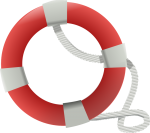

I wrote before that Twitter was like a magic cafe or an eternal, really good TESOL conference, but it can actually be a lifeline in times of disaster.
When the Tohoku Earthquake hit Japan, I was in California, but I was using Twitter at the time, on my @readable account with a lot of Japanese users. Many of them quickly tweeted 地震㠖“it’s an earthquake.” I realized something was wrong when, even fifteen minutes later, they were tweeting things like ã¾ã ゆれる–“it’s still shaking.”
For people who were and are in a disaster area and are not totally fluent in the local language, the situation can range from stressful to life-threatening. Even being in the Tokyo area (distant from the tsunami and major quake damage), with aftershocks, confusing power outages, train stoppages, and food shortages, is proving a challenge for many people. People who have made a good effort to learn Japanese are still finding that a whole host of new vocabulary is cropping up–planned power outage, aftershock, evacuation, contamination, nuclear power plant, and so on.
For the first couple of days, information from official sources was hard to get (at least overseas) in English–people kept saying to watch NHK World News, but when I turned it on, it was often just a loop of tsunami warnings, or a loop of translated news that I knew to be many hours old. (I knew the news was old because Twitterers like @makiwi, a food writer, and @TimeOutTokyo, an entertainment magazine site’s account, were tweeting live news in English–read about Six 6 Tokyo Tweeters Who Kept the City Informed here. And while NHK World News was behind, CNN and MSNBC and so on were woefully behind, and just so bad overall that I quit bothering with them. Meanwhile, BBC’s radio announcers mangled Japanese place names so badly that I couldn’t understand where they meant, which was pretty useless. While there was some good mainstream reporting later [caveat], I would not currently rely on these news outlets in a crisis where I needed to make decisions.)
During this time, and even (to a great extent) now, if you wanted to get information about things like the current status of the nuclear plants, who could help with emergency translation (seriously–medical experts were volunteering on the spot!), what all those microsieverts and millisieverts meant, where you could get shelter, how you could get from Point A to Point B with the expressways closed, where get temporary medication refills, which train lines were running, where to buy bread and batteries, how to use Google People Finder to check on survivors, who would take English-speaking volunteers, where to get information on cooking with limited resources, how to extend a visa or replace a passport, and so on, you could find the answers on Twitter. And during the aftermath, many of my Japanese friends say that Twitter has also helped them feel less alone, more reassured, and constantly encouraged, despite the stress and confusion. Some people have criticized Twitter for spreading hoaxes and rumors, but those spread by word of mouth, too (and for, heaven’s sake, even newspapers). Critical thinking, asking questions, and checking with reliable Twitterers all go a long way.
People rapidly came together on Twitter to help each other find information, connect users to other users who could translate something or supply an answer, and otherwise assist each other (even outright offering spare rooms to strangers). I noticed people’s lists of followers exploding, and not just those (like @makiwi and @TimeOutTokyo) who were valiantly translating NHK live and otherwise providing information you couldn’t get anywhere else.
Anyway, I can tell you that if I’d been in Japan, I wouldn’t have wanted to have been without Twitter. At the moment of a crisis, of course, it’s better to head for high ground, get under your desk, or whatever rather than checking Twitter (although at least one person was apparently rescued from a rooftop due to Twitter, since he wasn’t able to make a call but could send a tweet!). After that first moment, though, Twitter’s usefulness really kicks in. Disasters of one kind or another–floods, invasions, earthquakes, wildfires, uprisings–can happen almost anywhere. And despite the way we humans naturally tend to think, you’re not immune to disasters if you’re an outsider who is only there for a year or two: without fully-developed family and social networks, high-level language skills, knowledge of your surroundings, a fully-stocked household, and so on, you are probably more vulnerable.
Of course, you can’t necessarily sit there and wait for information to flow in–you need to either already have a well-developed Twitter network or be willing to seek out and find additional useful people to follow (or both). And you need be adventurous and creative in your use of English and the local language to search Twitter for the information you need (and not hesitate to ask people who might be helpful). Two places to start are 1) my Twitter guide for ESL students (simplified, but suitable for anyone, including people who use Twitter but haven’t explored its various functions–hashtags, for example, became very useful for regional information-sharing), and 2) my Twitter lists. To use Twitter lists, click on the name of the list and then the “Following: ” tab at the top. You can choose to follow individual members, who will show up in your Twitter timeline as usual. Or you can follow the whole list, but the members won’t show up in your timeline unless you also follow them individually. To read tweets from the list, you’ll have to go look at the list in your Twitter app or on Twitter.com.
Anyway, sorry for the length, but I hope this is useful to someone (although I suppose it’s better if it’s not, eh?). If you have any questions, let me know–and take care!
Leave a Reply